Counseling Strategies Assessment
VerifiedAdded on 2019/11/20
|5
|1220
|579
Homework Assignment
AI Summary
This assignment comprises two parts: short answer questions and a case study. The short answer section explores various counseling strategies, including open-ended questions, affirmations, reflective listening, summaries, clarifications, reviewing, building rapport, and addressing specific scenarios like mental health disorders and self-esteem problems. It also delves into ethical considerations in counseling, such as maintaining client privacy, knowing one's limits, and handling potential conflicts of interest. The case study focuses on a client named Ruth, who is experiencing bullying, parental separation, and aggression. The assignment requires analyzing Ruth's issues, proposing strategies for intervention, identifying potential obstacles, and outlining a plan for effective counseling, adhering to ethical guidelines.
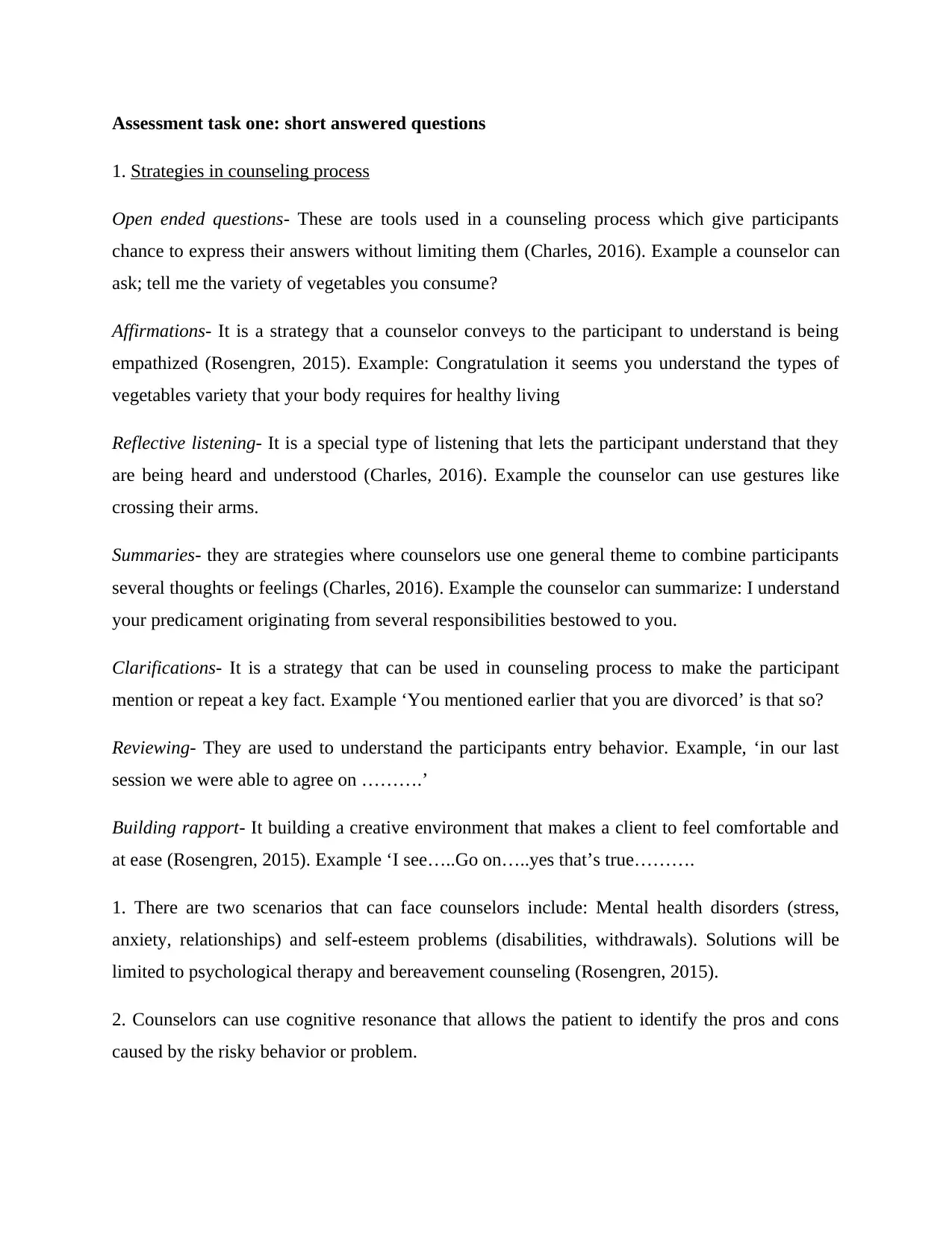
Assessment task one: short answered questions
1. Strategies in counseling process
Open ended questions- These are tools used in a counseling process which give participants
chance to express their answers without limiting them (Charles, 2016). Example a counselor can
ask; tell me the variety of vegetables you consume?
Affirmations- It is a strategy that a counselor conveys to the participant to understand is being
empathized (Rosengren, 2015). Example: Congratulation it seems you understand the types of
vegetables variety that your body requires for healthy living
Reflective listening- It is a special type of listening that lets the participant understand that they
are being heard and understood (Charles, 2016). Example the counselor can use gestures like
crossing their arms.
Summaries- they are strategies where counselors use one general theme to combine participants
several thoughts or feelings (Charles, 2016). Example the counselor can summarize: I understand
your predicament originating from several responsibilities bestowed to you.
Clarifications- It is a strategy that can be used in counseling process to make the participant
mention or repeat a key fact. Example ‘You mentioned earlier that you are divorced’ is that so?
Reviewing- They are used to understand the participants entry behavior. Example, ‘in our last
session we were able to agree on ……….’
Building rapport- It building a creative environment that makes a client to feel comfortable and
at ease (Rosengren, 2015). Example ‘I see…..Go on…..yes that’s true……….
1. There are two scenarios that can face counselors include: Mental health disorders (stress,
anxiety, relationships) and self-esteem problems (disabilities, withdrawals). Solutions will be
limited to psychological therapy and bereavement counseling (Rosengren, 2015).
2. Counselors can use cognitive resonance that allows the patient to identify the pros and cons
caused by the risky behavior or problem.
1. Strategies in counseling process
Open ended questions- These are tools used in a counseling process which give participants
chance to express their answers without limiting them (Charles, 2016). Example a counselor can
ask; tell me the variety of vegetables you consume?
Affirmations- It is a strategy that a counselor conveys to the participant to understand is being
empathized (Rosengren, 2015). Example: Congratulation it seems you understand the types of
vegetables variety that your body requires for healthy living
Reflective listening- It is a special type of listening that lets the participant understand that they
are being heard and understood (Charles, 2016). Example the counselor can use gestures like
crossing their arms.
Summaries- they are strategies where counselors use one general theme to combine participants
several thoughts or feelings (Charles, 2016). Example the counselor can summarize: I understand
your predicament originating from several responsibilities bestowed to you.
Clarifications- It is a strategy that can be used in counseling process to make the participant
mention or repeat a key fact. Example ‘You mentioned earlier that you are divorced’ is that so?
Reviewing- They are used to understand the participants entry behavior. Example, ‘in our last
session we were able to agree on ……….’
Building rapport- It building a creative environment that makes a client to feel comfortable and
at ease (Rosengren, 2015). Example ‘I see…..Go on…..yes that’s true……….
1. There are two scenarios that can face counselors include: Mental health disorders (stress,
anxiety, relationships) and self-esteem problems (disabilities, withdrawals). Solutions will be
limited to psychological therapy and bereavement counseling (Rosengren, 2015).
2. Counselors can use cognitive resonance that allows the patient to identify the pros and cons
caused by the risky behavior or problem.
Paraphrase This Document
Need a fresh take? Get an instant paraphrase of this document with our AI Paraphraser
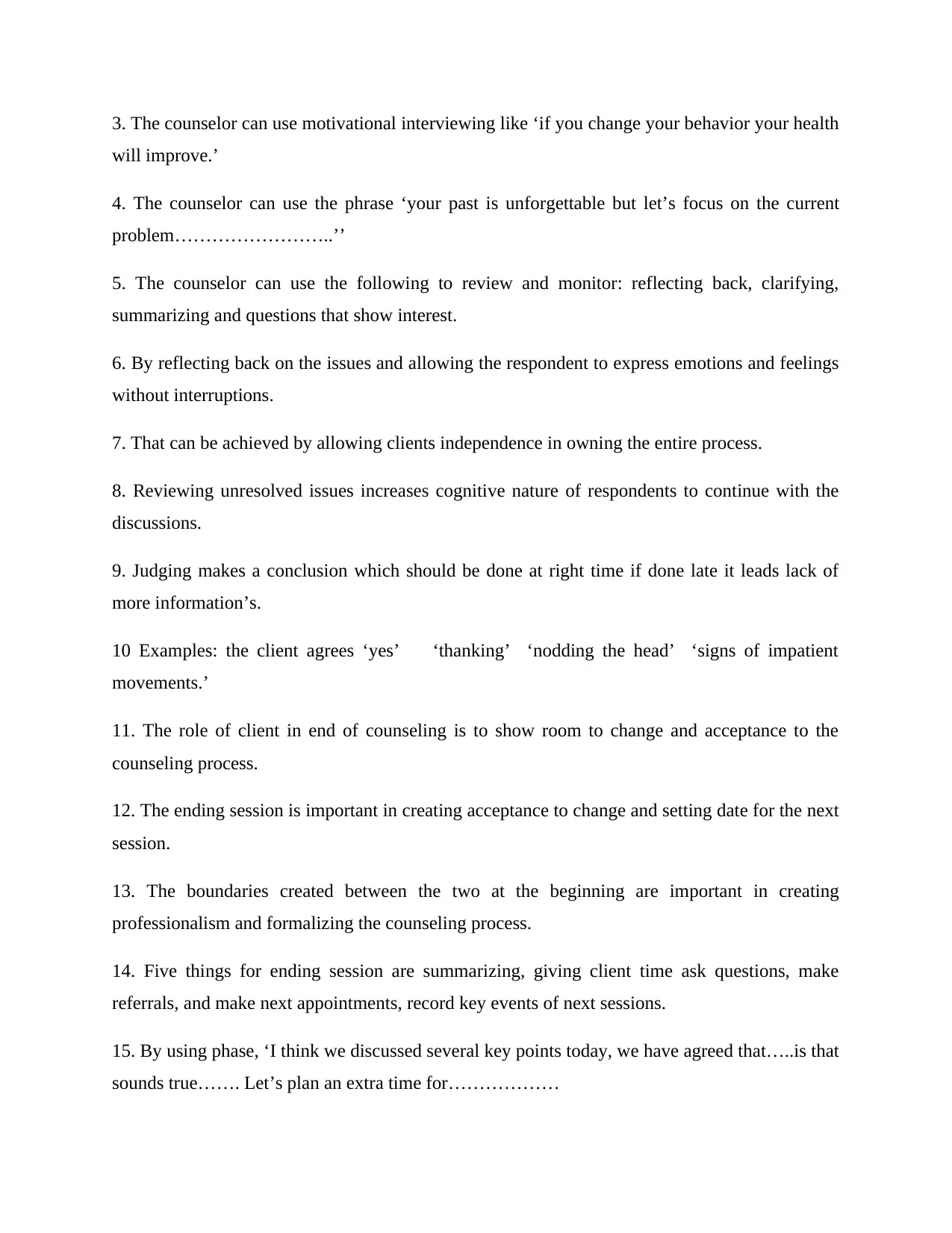
3. The counselor can use motivational interviewing like ‘if you change your behavior your health
will improve.’
4. The counselor can use the phrase ‘your past is unforgettable but let’s focus on the current
problem……………………..’’
5. The counselor can use the following to review and monitor: reflecting back, clarifying,
summarizing and questions that show interest.
6. By reflecting back on the issues and allowing the respondent to express emotions and feelings
without interruptions.
7. That can be achieved by allowing clients independence in owning the entire process.
8. Reviewing unresolved issues increases cognitive nature of respondents to continue with the
discussions.
9. Judging makes a conclusion which should be done at right time if done late it leads lack of
more information’s.
10 Examples: the client agrees ‘yes’ ‘thanking’ ‘nodding the head’ ‘signs of impatient
movements.’
11. The role of client in end of counseling is to show room to change and acceptance to the
counseling process.
12. The ending session is important in creating acceptance to change and setting date for the next
session.
13. The boundaries created between the two at the beginning are important in creating
professionalism and formalizing the counseling process.
14. Five things for ending session are summarizing, giving client time ask questions, make
referrals, and make next appointments, record key events of next sessions.
15. By using phase, ‘I think we discussed several key points today, we have agreed that…..is that
sounds true……. Let’s plan an extra time for………………
will improve.’
4. The counselor can use the phrase ‘your past is unforgettable but let’s focus on the current
problem……………………..’’
5. The counselor can use the following to review and monitor: reflecting back, clarifying,
summarizing and questions that show interest.
6. By reflecting back on the issues and allowing the respondent to express emotions and feelings
without interruptions.
7. That can be achieved by allowing clients independence in owning the entire process.
8. Reviewing unresolved issues increases cognitive nature of respondents to continue with the
discussions.
9. Judging makes a conclusion which should be done at right time if done late it leads lack of
more information’s.
10 Examples: the client agrees ‘yes’ ‘thanking’ ‘nodding the head’ ‘signs of impatient
movements.’
11. The role of client in end of counseling is to show room to change and acceptance to the
counseling process.
12. The ending session is important in creating acceptance to change and setting date for the next
session.
13. The boundaries created between the two at the beginning are important in creating
professionalism and formalizing the counseling process.
14. Five things for ending session are summarizing, giving client time ask questions, make
referrals, and make next appointments, record key events of next sessions.
15. By using phase, ‘I think we discussed several key points today, we have agreed that…..is that
sounds true……. Let’s plan an extra time for………………
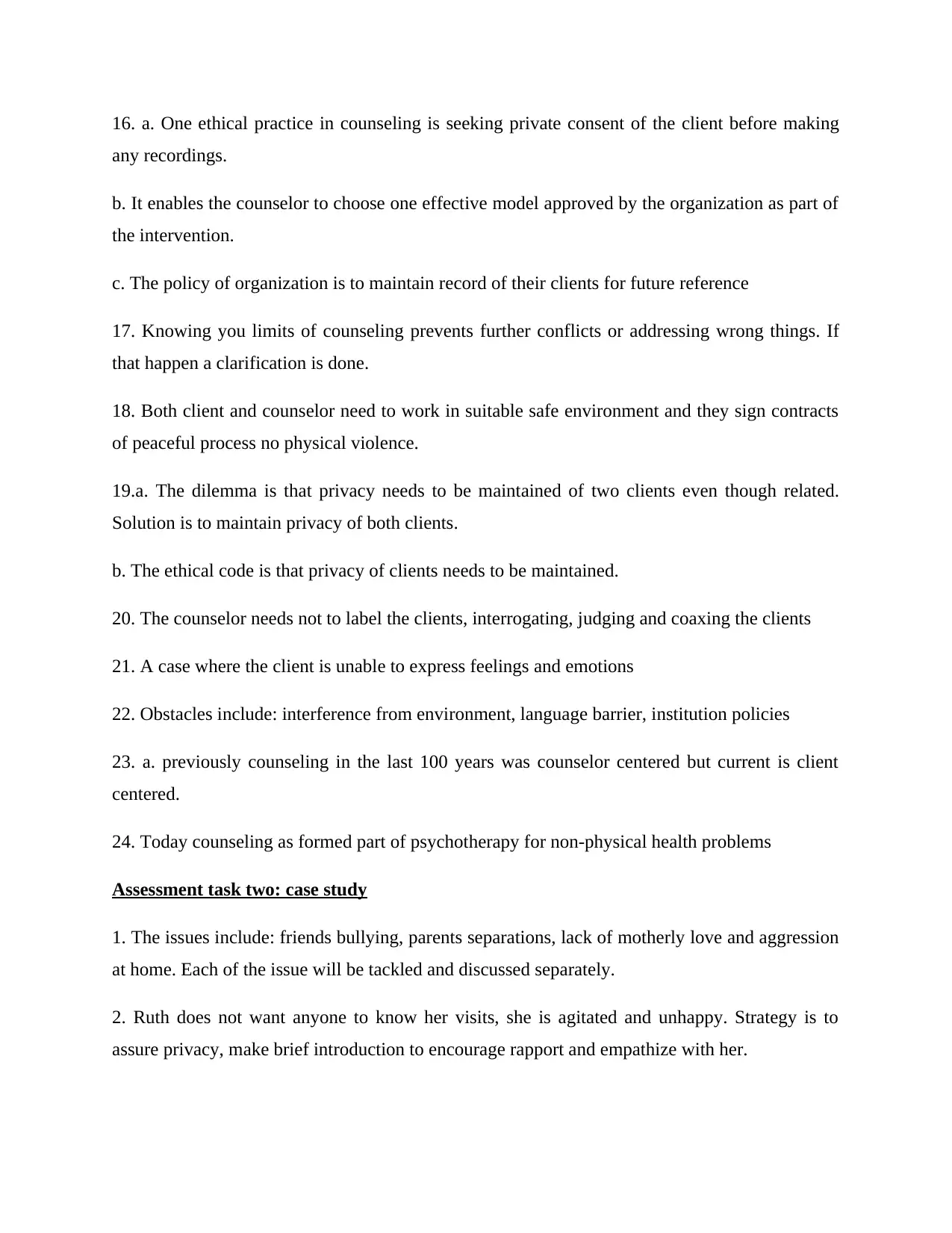
16. a. One ethical practice in counseling is seeking private consent of the client before making
any recordings.
b. It enables the counselor to choose one effective model approved by the organization as part of
the intervention.
c. The policy of organization is to maintain record of their clients for future reference
17. Knowing you limits of counseling prevents further conflicts or addressing wrong things. If
that happen a clarification is done.
18. Both client and counselor need to work in suitable safe environment and they sign contracts
of peaceful process no physical violence.
19.a. The dilemma is that privacy needs to be maintained of two clients even though related.
Solution is to maintain privacy of both clients.
b. The ethical code is that privacy of clients needs to be maintained.
20. The counselor needs not to label the clients, interrogating, judging and coaxing the clients
21. A case where the client is unable to express feelings and emotions
22. Obstacles include: interference from environment, language barrier, institution policies
23. a. previously counseling in the last 100 years was counselor centered but current is client
centered.
24. Today counseling as formed part of psychotherapy for non-physical health problems
Assessment task two: case study
1. The issues include: friends bullying, parents separations, lack of motherly love and aggression
at home. Each of the issue will be tackled and discussed separately.
2. Ruth does not want anyone to know her visits, she is agitated and unhappy. Strategy is to
assure privacy, make brief introduction to encourage rapport and empathize with her.
any recordings.
b. It enables the counselor to choose one effective model approved by the organization as part of
the intervention.
c. The policy of organization is to maintain record of their clients for future reference
17. Knowing you limits of counseling prevents further conflicts or addressing wrong things. If
that happen a clarification is done.
18. Both client and counselor need to work in suitable safe environment and they sign contracts
of peaceful process no physical violence.
19.a. The dilemma is that privacy needs to be maintained of two clients even though related.
Solution is to maintain privacy of both clients.
b. The ethical code is that privacy of clients needs to be maintained.
20. The counselor needs not to label the clients, interrogating, judging and coaxing the clients
21. A case where the client is unable to express feelings and emotions
22. Obstacles include: interference from environment, language barrier, institution policies
23. a. previously counseling in the last 100 years was counselor centered but current is client
centered.
24. Today counseling as formed part of psychotherapy for non-physical health problems
Assessment task two: case study
1. The issues include: friends bullying, parents separations, lack of motherly love and aggression
at home. Each of the issue will be tackled and discussed separately.
2. Ruth does not want anyone to know her visits, she is agitated and unhappy. Strategy is to
assure privacy, make brief introduction to encourage rapport and empathize with her.
⊘ This is a preview!⊘
Do you want full access?
Subscribe today to unlock all pages.

Trusted by 1+ million students worldwide
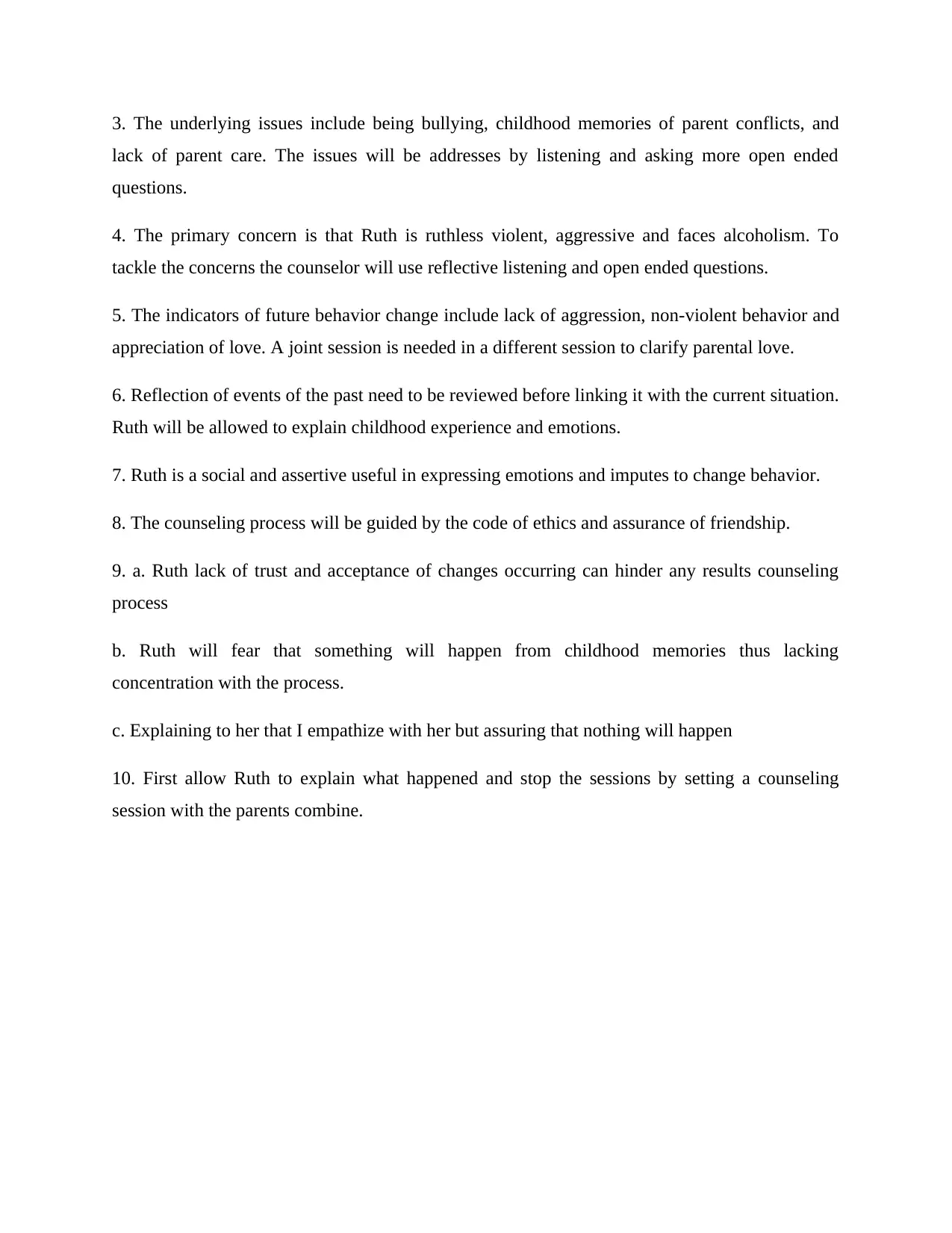
3. The underlying issues include being bullying, childhood memories of parent conflicts, and
lack of parent care. The issues will be addresses by listening and asking more open ended
questions.
4. The primary concern is that Ruth is ruthless violent, aggressive and faces alcoholism. To
tackle the concerns the counselor will use reflective listening and open ended questions.
5. The indicators of future behavior change include lack of aggression, non-violent behavior and
appreciation of love. A joint session is needed in a different session to clarify parental love.
6. Reflection of events of the past need to be reviewed before linking it with the current situation.
Ruth will be allowed to explain childhood experience and emotions.
7. Ruth is a social and assertive useful in expressing emotions and imputes to change behavior.
8. The counseling process will be guided by the code of ethics and assurance of friendship.
9. a. Ruth lack of trust and acceptance of changes occurring can hinder any results counseling
process
b. Ruth will fear that something will happen from childhood memories thus lacking
concentration with the process.
c. Explaining to her that I empathize with her but assuring that nothing will happen
10. First allow Ruth to explain what happened and stop the sessions by setting a counseling
session with the parents combine.
lack of parent care. The issues will be addresses by listening and asking more open ended
questions.
4. The primary concern is that Ruth is ruthless violent, aggressive and faces alcoholism. To
tackle the concerns the counselor will use reflective listening and open ended questions.
5. The indicators of future behavior change include lack of aggression, non-violent behavior and
appreciation of love. A joint session is needed in a different session to clarify parental love.
6. Reflection of events of the past need to be reviewed before linking it with the current situation.
Ruth will be allowed to explain childhood experience and emotions.
7. Ruth is a social and assertive useful in expressing emotions and imputes to change behavior.
8. The counseling process will be guided by the code of ethics and assurance of friendship.
9. a. Ruth lack of trust and acceptance of changes occurring can hinder any results counseling
process
b. Ruth will fear that something will happen from childhood memories thus lacking
concentration with the process.
c. Explaining to her that I empathize with her but assuring that nothing will happen
10. First allow Ruth to explain what happened and stop the sessions by setting a counseling
session with the parents combine.
Paraphrase This Document
Need a fresh take? Get an instant paraphrase of this document with our AI Paraphraser
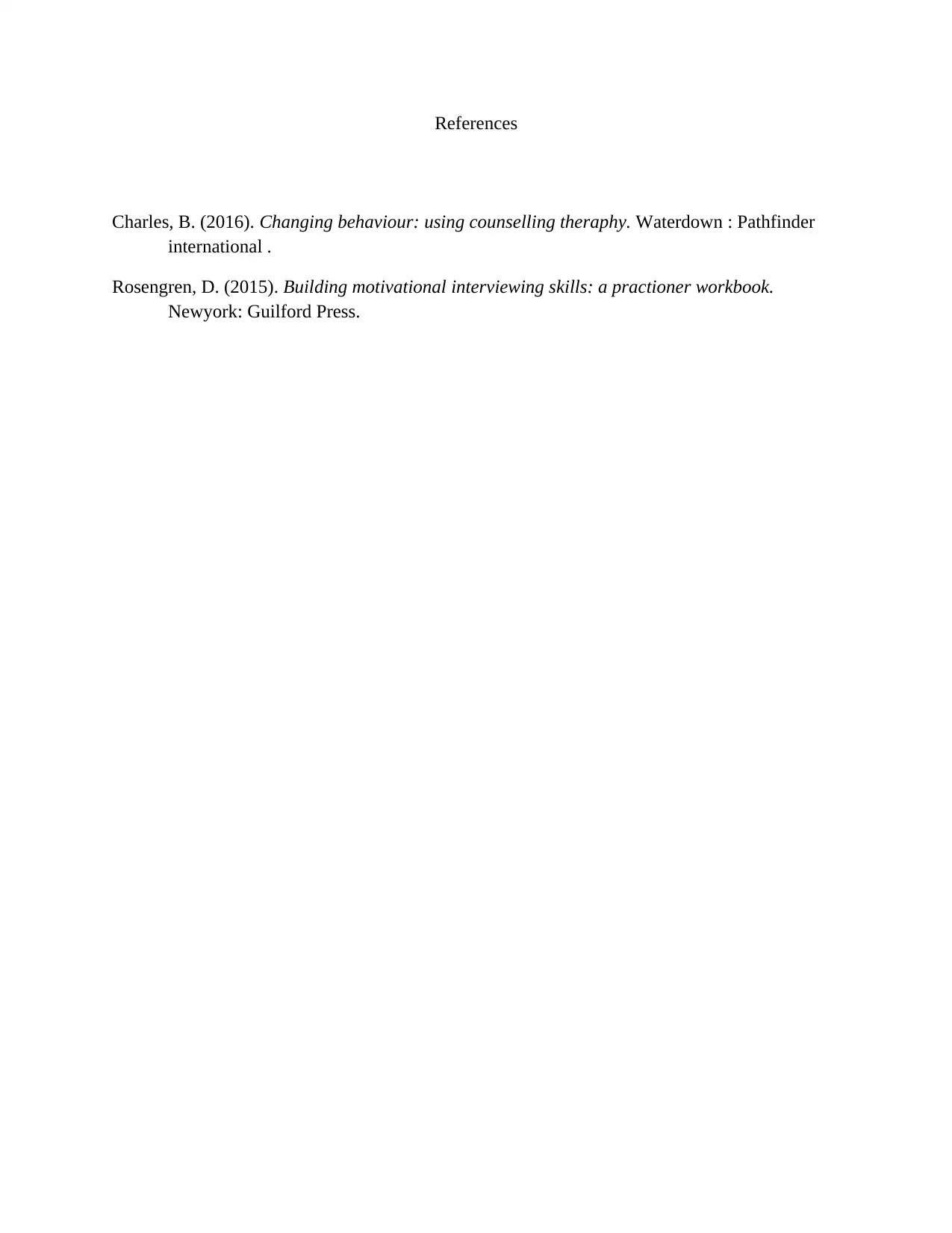
References
Charles, B. (2016). Changing behaviour: using counselling theraphy. Waterdown : Pathfinder
international .
Rosengren, D. (2015). Building motivational interviewing skills: a practioner workbook.
Newyork: Guilford Press.
Charles, B. (2016). Changing behaviour: using counselling theraphy. Waterdown : Pathfinder
international .
Rosengren, D. (2015). Building motivational interviewing skills: a practioner workbook.
Newyork: Guilford Press.
1 out of 5
Related Documents
Your All-in-One AI-Powered Toolkit for Academic Success.
+13062052269
info@desklib.com
Available 24*7 on WhatsApp / Email
![[object Object]](/_next/static/media/star-bottom.7253800d.svg)
Unlock your academic potential
Copyright © 2020–2025 A2Z Services. All Rights Reserved. Developed and managed by ZUCOL.





